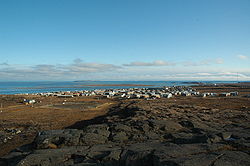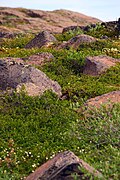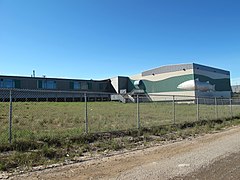Kugluktuk
Kugluktuk
Qurluqtuq ᖁᕐᓗᖅᑐᖅ | |
|---|---|
 Hill top view of Kugluktuk | |
| Coordinates: 67°49′36″N 115°05′36″W / 67.82667°N 115.09333°W[1] | |
| Country | Canada |
| Territory | Nunavut |
| Region | Kitikmeot |
| Electoral district | Kugluktuk |
| Government | |
| • Mayor | Ryan Nivingalok |
| • MLA | Bobby Anavilok |
| Area (2021)[4] | |
| • Land | 538.99 km2 (208.11 sq mi) |
| Elevation | 23 m (75 ft) |
| Population (2021)[4] | |
• Total | 1,382 |
| • Density | 2.6/km2 (7/sq mi) |
| • DPL[6] | 956 |
| Time zone | UTC−07:00 (MST) |
| • Summer (DST) | UTC−06:00 (MDT) |
| Canadian Postal code | |
| Area code | 867 |
Kugluktuk (Qurluqtuq, lit. 'the place of moving water';[7] Inuktitut syllabics: ᖁᕐᓗᖅᑐᖅ; Inuktitut pronunciation: [quʁluqtuq]), known as Coppermine until 1 January 1996, is a hamlet at the mouth of the Coppermine River in the Kitikmeot Region of Nunavut, Canada, on Coronation Gulf, southwest of Victoria Island. It is Nunavut's westernmost community, near the border with the Northwest Territories.
The area's traditional language is Inuinnaqtun, which is written in the Latin alphabet, rather than the syllabics of the Inuktitut writing system. Like Cambridge Bay, Bathurst Inlet, and Umingmaktok, syllabics are rarely seen and are used mainly by the Government of Nunavut.
History
[edit]Prior to European contact, Dene travelled to the area and interacted acrimoniously with nearby Thule and Inuit, sometimes ending in deadly raids against each other (see Bloody Falls massacre). In July 1821, the British Coppermine expedition team reached the mouth of the Coppermine River, just next to the present day community of Kugluktuk.[8] Arctic explorers Peter Warren Dease and Thomas Simpson reached this area in 1838 to survey from Coronation Gulf at the mouth of Coppermine River to southern Boothia Peninsula. Dease noted that while his group camped near Bloody Falls, the Copper Inuit would flee when his party approached their camps. Between 1913 and 1916, anthropologist Diamond Jenness studied and recorded the traditional lifestyle of Inuit around Kugluktuk. Danish fur trader Christian Klengenberg constructed a trading post in 1916 which formed a permanent year-round community known as Fort Hearne. The Hudson Bay Company established a trading post at this community in 1927. Fort Hearne was renamed to Coppermine in 1930. The Royal Canadian Mounted Police built a police station in 1932. The former name of the community, Coppermine, was named after its namesake Coppermine River.[7]
An Indian federal day school (Federal Tent Hostel at Coppermine) opened in 1951 and closed in 1959.[9] Construction of the Distant Early Warning Line (DEW Line) sites, Lady Franklin Point and Bernard Harbour, on the opposite shore of Coronation Gulf in 1955 created some employment opportunities for the locals.
In 1982, a division plebiscite was held. About 80% of the population in what is now Nunavut voted in favour of division; Coppermine was one of only two communities to vote against it, Cambridge Bay was the other.[10]
In 1996, a healing ceremony between Dene and Inuit took place to reconcile for historical grievances. The community also changed its name from Coppermine to Kugluktuk on January 1, 1996.[11] In June 2004, a fuel line broke in the centre of Kugluktuk, spilling 2,000 L (440 imp gal; 530 US gal) of diesel fuel.[citation needed]
Demographics
[edit]| Year | Pop. | ±% |
|---|---|---|
| 1976 | 758 | — |
| 1981 | 809 | +6.7% |
| 1986 | 888 | +9.8% |
| 1991 | 1,059 | +19.3% |
| 1996 | 1,201 | +13.4% |
| 2001 | 1,212 | +0.9% |
| 2006 | 1,302 | +7.4% |
| 2011 | 1,450 | +11.4% |
| 2016 | 1,491 | +2.8% |
| 2021 | 1,382 | −7.3% |
| Source: Statistics Canada [4][12][13][14][15][16][17][18][19][20] | ||
As a census subdivision in the 2021 Canadian census conducted by Statistics Canada, Kugluktuk had a population of 1,382 living in 397 of its 438 total private dwellings, a change of -7.3% from its 2016 population of 1,491. With a land area of 538.99 km2 (208.11 sq mi), it had a population density of 2.6/km2 in 2021.[4]
As a designated place in the 2021 census, Kugluktuk had a population of 956 living in 265 of its 296 total private dwellings, a change of -9.6% from its 2016 population of 1,057. With a land area of 0.34 km2 (0.13 sq mi), it had a population density of 2,811.8/km2 (7,282.4/sq mi) in 2021.[6]
Infrastructure
[edit]The community has been served by the Qiniq network since 2005. Qiniq is a fixed wireless service to homes and businesses, connecting to the outside world via a satellite backbone. The Qiniq network is designed and operated by SSi Canada. In 2017, the network was upgraded to 4G LTE technology, and 2G-GSM for mobile voice.
Education
[edit]Kugluktuk's two schools are Kugluktuk High School and Jimmy Hikok Ilihakvik.
Geography
[edit]Kugluktuk is on the shore of the Arctic Ocean. The surrounding landscape is dominated by the rocky and often barren Canadian Shield. The region has a subarctic climate, but barely so, with July having an average of 10.9 °C (51.6 °F). It has cold, dry winters, and moderate snowfall that is relatively high for its latitude. Trees do exist in the region due to microclimate,[7] but they are dwarfed and extremely sparse.
Flora
[edit]Plant growth in the region during the summer includes small shrubs, grass, moss, lichens, blueberries, blackberries, cranberries, various flowers, and dwarf willow and birch trees.
Climate
[edit]Kugluktuk features a subarctic climate (Köppen climate classification: Dfc); like most of mainland Nunavut; with wet summers and dry winters. It is in the transitional zone to a cold tundra climate (ET), but falls outside of it, since its warmest month of July surpasses the 10 °C (50 °F) isotherm, averaging 10.9 °C (51.6 °F).
The highest temperature ever recorded in Kugluktuk was 34.9 °C (94.8 °F) on 15 July 1989.[21] The coldest temperature ever recorded was −50.0 °C (−58.0 °F) on 2 February 1968.[22]
| Climate data for Kugluktuk (Kugluktuk Airport) WMO ID: 71938; coordinates 67°49′00″N 115°08′38″W / 67.81667°N 115.14389°W; elevation: 22.6 m (74 ft); 1991–2020 normals, extremes 1930–present[a] | |||||||||||||
|---|---|---|---|---|---|---|---|---|---|---|---|---|---|
| Month | Jan | Feb | Mar | Apr | May | Jun | Jul | Aug | Sep | Oct | Nov | Dec | Year |
| Record high humidex | 0.3 | −1.7 | −0.3 | 8.9 | 19.8 | 30.3 | 36.8 | 36.8 | 25.8 | 13.1 | 2.2 | −1.5 | 36.8 |
| Record high °C (°F) | 0.8 (33.4) |
1.1 (34.0) |
−0.1 (31.8) |
9.8 (49.6) |
23.3 (73.9) |
32.5 (90.5) |
34.9 (94.8) |
30.3 (86.5) |
26.1 (79.0) |
13.9 (57.0) |
4.4 (39.9) |
4.4 (39.9) |
34.9 (94.8) |
| Mean daily maximum °C (°F) | −22.5 (−8.5) |
−22.8 (−9.0) |
−20.1 (−4.2) |
−11.6 (11.1) |
−0.6 (30.9) |
10.4 (50.7) |
15.8 (60.4) |
13.7 (56.7) |
6.8 (44.2) |
−2.9 (26.8) |
−13.2 (8.2) |
−20.1 (−4.2) |
−5.6 (21.9) |
| Daily mean °C (°F) | −26.6 (−15.9) |
−27.0 (−16.6) |
−24.6 (−12.3) |
−16.4 (2.5) |
−4.5 (23.9) |
5.9 (42.6) |
11.2 (52.2) |
9.6 (49.3) |
3.6 (38.5) |
−5.9 (21.4) |
−17.1 (1.2) |
−24.1 (−11.4) |
−9.7 (14.5) |
| Mean daily minimum °C (°F) | −30.7 (−23.3) |
−31.3 (−24.3) |
−29.1 (−20.4) |
−21.2 (−6.2) |
−8.5 (16.7) |
1.4 (34.5) |
6.5 (43.7) |
5.4 (41.7) |
0.3 (32.5) |
−9.0 (15.8) |
−21.0 (−5.8) |
−28.1 (−18.6) |
−13.8 (7.2) |
| Record low °C (°F) | −47.8 (−54.0) |
−50.0 (−58.0) |
−48.9 (−56.0) |
−43.9 (−47.0) |
−31.1 (−24.0) |
−15.0 (5.0) |
−0.8 (30.6) |
−4.4 (24.1) |
−20.0 (−4.0) |
−35.4 (−31.7) |
−41.1 (−42.0) |
−45.0 (−49.0) |
−50.0 (−58.0) |
| Record low wind chill | −64.3 | −64.4 | −65.0 | −54.4 | −39.7 | −15.6 | −5.9 | −11.8 | −22.9 | −46.5 | −54.1 | −61.5 | −65.0 |
| Average precipitation mm (inches) | 9.2 (0.36) |
7.0 (0.28) |
9.3 (0.37) |
7.9 (0.31) |
14.5 (0.57) |
17.4 (0.69) |
45.2 (1.78) |
42.3 (1.67) |
35.5 (1.40) |
23.3 (0.92) |
10.9 (0.43) |
10.6 (0.42) |
233.1 (9.18) |
| Average rainfall mm (inches) | 0.1 (0.00) |
0.0 (0.0) |
0.0 (0.0) |
0.1 (0.00) |
4.3 (0.17) |
14.6 (0.57) |
44.4 (1.75) |
44.9 (1.77) |
31.4 (1.24) |
4.7 (0.19) |
0.0 (0.0) |
0.0 (0.0) |
144.5 (5.69) |
| Average snowfall cm (inches) | 19.6 (7.7) |
16.3 (6.4) |
19.4 (7.6) |
18.2 (7.2) |
16.2 (6.4) |
2.1 (0.8) |
0.0 (0.0) |
0.2 (0.1) |
7.7 (3.0) |
35.0 (13.8) |
25.5 (10.0) |
21.9 (8.6) |
182.1 (71.7) |
| Average precipitation days (≥ 0.2 mm) | 9.7 | 8.7 | 10.1 | 7.7 | 8.5 | 8.3 | 11.8 | 13.0 | 13.0 | 14.5 | 10.6 | 10.3 | 126.2 |
| Average rainy days (≥ 0.2 mm) | 0.0 | 0.0 | 0.0 | 0.2 | 1.9 | 6.8 | 11.5 | 13.1 | 10.5 | 2.3 | 0.0 | 0.0 | 46.4 |
| Average snowy days (≥ 0.2 cm) | 10.5 | 10.1 | 11.6 | 9.5 | 7.2 | 1.3 | 0.1 | 0.2 | 3.7 | 14.5 | 13.4 | 11.6 | 93.6 |
| Average relative humidity (%) (at 1500 LST) | 76.7 | 75.1 | 77.5 | 82.3 | 83.1 | 70.2 | 64.8 | 69.8 | 75.5 | 84.7 | 80.9 | 77.8 | 76.5 |
| Average dew point °C (°F) | −30.6 (−23.1) |
−31.3 (−24.3) |
−30.2 (−22.4) |
−20.8 (−5.4) |
−7.5 (18.5) |
0.8 (33.4) |
5.5 (41.9) |
4.6 (40.3) |
−0.3 (31.5) |
−8.3 (17.1) |
−21.5 (−6.7) |
−29.7 (−21.5) |
−14.1 (6.6) |
| Mean monthly sunshine hours | 17.8 | 77.3 | 160.3 | 233.3 | 246.7 | 375.0 | 341.6 | 207.7 | 91.1 | 51.2 | 19.6 | 0.2 | 1,821.7 |
| Percent possible sunshine | 17.7 | 35.5 | 44.4 | 49.6 | 38.7 | 52.1 | 48.5 | 38.5 | 22.8 | 17.6 | 12.7 | 0.7 | 31.6 |
| Source: Environment and Climate Change Canada[23] (rain/rain days, snow/snow days, humidex, wind chill, humidity 1981–2010) Canadian Climate Normals 1981–2010[21][24][25] (dew point 1951–1980) | |||||||||||||
Notable people
[edit]Gallery
[edit]-
Kugluktuk NU
-
A lifeguard is stationed at the beach on hot days
-
Wildflowers in Kugluktuk
-
Grades 6 to 12 with a student population of about 150
-
The Roman Catholic Church at Kugluktuk
See also
[edit]Notes
[edit]- ^ Climate data was recorded at Coppermine from October 1930 to November 1977 and at Kugluktuk Airport from December 1977 to present.
References
[edit]- ^ "Kugluktuk". Geographical Names Data Base. Natural Resources Canada.
- ^ "Hamlet of Kugluktuk". Retrieved 31 December 2022.
- ^ "2021 General Election" (PDF). Elections Nunavut. Retrieved 26 December 2022.
- ^ a b c d "Population and dwelling counts: Canada, provinces and territories, and census subdivisions (municipalities), Nunavut". Statistics Canada. 9 February 2022. Retrieved 19 February 2022.
- ^ Elevation at airport. Canada Flight Supplement. Effective 0901Z 16 July 2020 to 0901Z 10 September 2020.
- ^ a b "Population and dwelling counts: Canada and designated places". Statistics Canada. 9 February 2022. Retrieved 8 May 2022.
- ^ a b c "History". Hamlet of Kugluktuk. Retrieved 14 May 2024.
- ^ Rosano, Michela (20 November 2023). "George Back: The expedition's artist". Canadian Geographic. Retrieved 25 October 2024.
- ^ "Federal Tent Hostel at Coppermine". National Centre for Truth and Reconciliation. 11 February 2021. Retrieved 25 October 2024.
- ^ "The 1982 Plebiscite on Division of the Northwest Territories: Regional Government and Federal Policy" (PDF). Archived from the original (PDF) on 10 December 2019. Retrieved 25 August 2010.
- ^ Saarela, Jeffery M.; Sokoloff, Paul C.; Bull, Roger D. (7 February 2017). "Vascular plant biodiversity of the lower Coppermine River valley and vicinity (Nunavut, Canada): an annotated checklist of an Arctic flora". PeerJ. 5: e2835. doi:10.7717/peerj.2835. ISSN 2167-8359. PMC 5300018. PMID 28194307.
- ^ "1976 Census of Canada: Population - Geographic Distributions" (PDF). Statistics Canada. June 1977. Retrieved 1 February 2022.
- ^ "1981 Census of Canada: Census subdivisions in decreasing population order" (PDF). Statistics Canada. May 1992. Retrieved 1 February 2022.
- ^ "1986 Census: Population - Census Divisions and Census Subdivisions" (PDF). Statistics Canada. September 1987. Retrieved 1 February 2022.
- ^ "91 Census: Census Divisions and Census Subdivisions - Population and Dwelling Counts" (PDF). Statistics Canada. April 1992. Retrieved 1 February 2022.
- ^ "96 Census: A National Overview - Population and Dwelling Counts" (PDF). Statistics Canada. April 1997. Retrieved 1 February 2022.
- ^ "Population and Dwelling Counts, for Canada, Provinces and Territories, and Census Subdivisions (Municipalities), 2001 and 1996 Censuses - 100% Data (Nunavut)". Statistics Canada. 15 August 2012. Retrieved 1 February 2022.
- ^ "Population and dwelling counts, for Canada, provinces and territories, and census subdivisions (municipalities), 2006 and 2001 censuses - 100% data (Nunavut)". Statistics Canada. 20 August 2021. Retrieved 1 February 2022.
- ^ "Population and dwelling counts, for Canada, provinces and territories, and census subdivisions (municipalities), 2011 and 2006 censuses (Nunavut)". Statistics Canada. 25 July 2021. Retrieved 1 February 2022.
- ^ "Population and dwelling counts, for Canada, provinces and territories, and census subdivisions (municipalities), 2016 and 2011 censuses – 100% data (Nunavut)". Statistics Canada. 8 February 2017. Retrieved 1 February 2022.
- ^ a b "Kugluktuk A *". Canadian Climate Normals 1981–2010. Environment and Climate Change Canada. Climate ID: 2300902. Retrieved 30 April 2014.
- ^ "February 1968". Canadian Climate Data. Environment and Climate Change Canada. Climate ID: 2300900. Retrieved 25 June 2016.
- ^ "Kugluktuk (Composite Station Threads)". Canadian Climate Normals 1991-2020 Data. Environment and Climate Change Canada. Archived from the original on 21 December 2023. Retrieved 21 December 2023.
- ^ "Canadian Climate Normals 1951–1980 Volume 2: Temperature" (PDF). Environment Canada. Archived from the original (PDF) on 9 August 2023. Retrieved 24 October 2020.
- ^ "Canadian Climate Normals 1951–1980 Volume 8: Atmospheric, Pressure, Temperature and Humidity" (PDF). Environment Canada. Archived from the original (PDF) on 9 August 2023. Retrieved 11 August 2023.
- Office of the Languages Commissioner of Nunavut – PDF Dialect Map
- Office of the Languages Commissioner of Nunavut – Writing systems
Further reading
[edit]- Dredge, L. A. Where the river meets the sea geology and landforms of the lower Coppermine River Valley and Kugluktuk, Nunavut. [Ottawa]: Geological Survey of Canada, 2001. ISBN 0-660-18550-4
- Pedersen, Lena, and Donna Stephania. Crime Prevention in Kugluktuk. Ottawa: Caledon Institute of Social Policy, 1999. ISBN 1-894159-61-6








